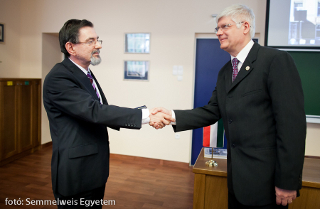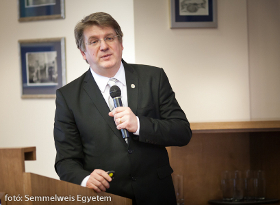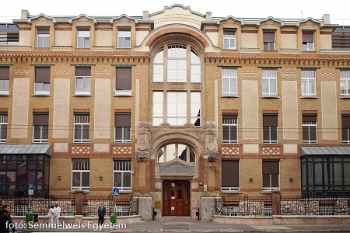
Dr. Ágoston Szél, rector of Semmelweis University, presented the ornamental key symbolising the key of the newly renovated Department of Ophthalmology to Director János Németh at a ceremony held in honour of the occasion.
Rector Szél recalled that he had first visited the Department as a medical student in 1978, where he spent about a year working as a night shift nurse during his studies; for this reason, he is very familiar with the building. Dr. Szél told the audience that at that time, he had no idea that some day he would be the one to officially open the Department’s newly renovated building as rector, making this is a particularly moving moment for him.
Minister of State for Health Miklós Szócska conveyed his congratulations on the successful renovation and expressed his wish for the seamless merger of the two ophthalmology buildings. According to his words, the pursuit for integration reflects very well how the profession is changing and how health care technologies evolve.
Director János Németh spoke about the scientific results of the Department. He highlighted, among others, the work of Dr. Zoltán Zsolt Nagy, who is working on the development of cataract surgery and whose femtolaser surgical procedures are well-known around the world. Dr. Gábor Holló and his team are carrying out work on the diagnostics and treatment of glaucoma that is unparalleled in the region. Director Németh also brought attention to the Department’s Infant Eye Rescue Programme and the establishment of the Hungarian Bionic Vision Centre, and gave an account of the telemedicinal digital fundus screening initiative, which commenced in May of last year.

Dr. Zoltán Zsolt Nagy, who was appointed by the rector to supervise the entire renovation project, held a presentation on the history of the Department. He recollected that, at the time of its opening in 1908, this was the most modern eye clinic of its age. Its southern wing sustained several direct hits during the Revolution of 1956, some of which had still been visible earlier this year. As Dr. Nagy recalled, the Senate of Semmelweis University voted in favour of integrating and renovating the University’s two ophthalmology departments in 2005. However, due to financial difficulties, work on the HUF 2 billion (approx. EUR 6.7 million) renovation project had to be stopped in 2010 for a period of two years. Despite this setback, the renovation work was completed and, once the building received its occupation permit in January of this year, the integration work commenced.
The professor also mentioned some interesting facts about the renovation. For example, the library and the original oak desks and chairs of the classroom were renovated with the Dean’s support. In addition, after the the façade was cleaned, previously hidden patterns suddenly became visible on it. Dr. Zoltán Zsolt Nagy told the audience that two books have been published on the occasion of the inauguration, which contains further interesting facts and a detailed account of the renovation of the ophthalmology building.

Perhaps the most beautiful ophthalmology department in Europe – in the words of Dr. János Németh – the building was designed by two of the most eminent architects of the early 20th century, Flóris Korb and Kálmán Giergl. The plans for the current renovation were drawn up by the teams at Attik’Art Kft. and Iparterv Zrt. under the leadership of architect Zoltán Schrammel. The final resulof the work is worthy of Semmelweis University’s reputation, Director Németh concluded.
In the future, all of Semmelweis University’s eye patients will be treated at the fully renovated Department of Ophthalmology: every type of available services, such as the outpatient department and six world-class operating theatres, is now located in a single building. This is extremely important, for it allows those with eye injuries to receive the highest level of emergency medical care. Uniquely, the clinic provides surgical care to children with eye injuries seven days a week.
The two clinics’ instruments have also been merged, so that the special microsurgical tools and medical expertise are now all available in one place. The merger has created what is perhaps the most superior institution in its specialty area both in terms of the quality and magnitude of its medical services and in terms of its scientific activities.
Between 210,000 and 225,000 patients are examined in the Department’s outpatient clinic each year, while the number of eye surgeries performed per annum stands at around 7500.
Szilvia Tóth-Szabó
Translated by Gina Varga-Gönczi


